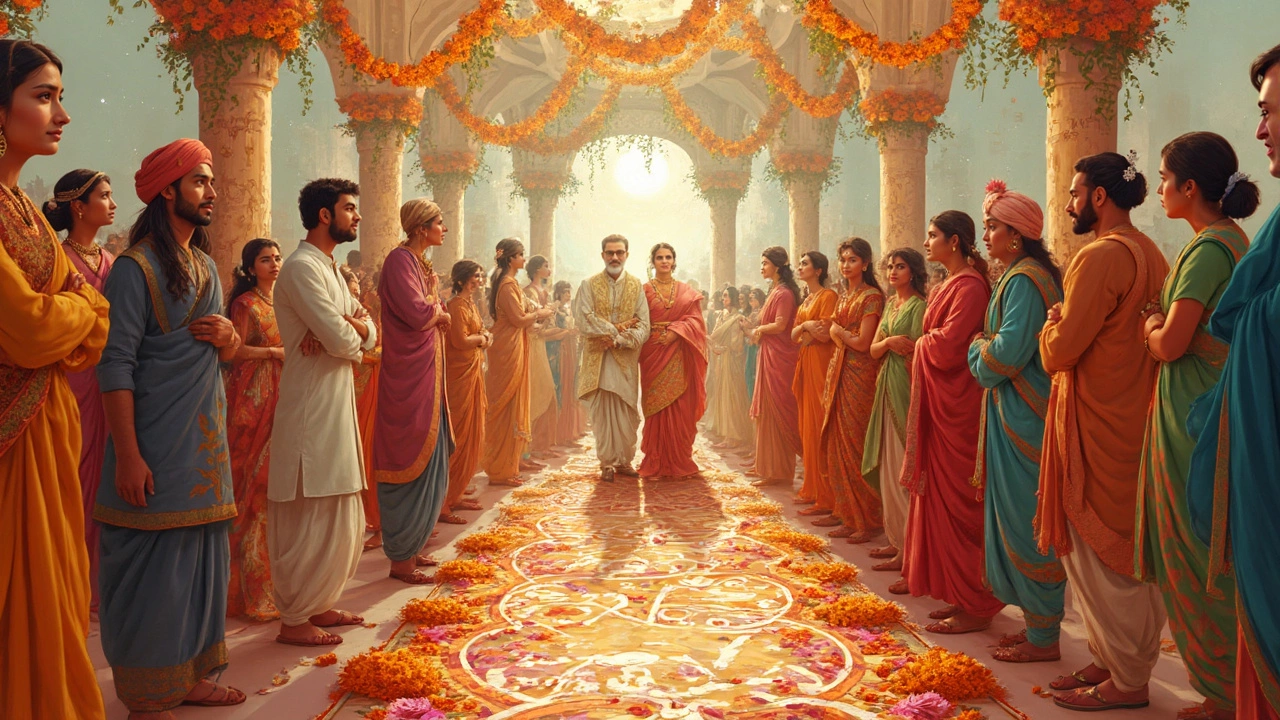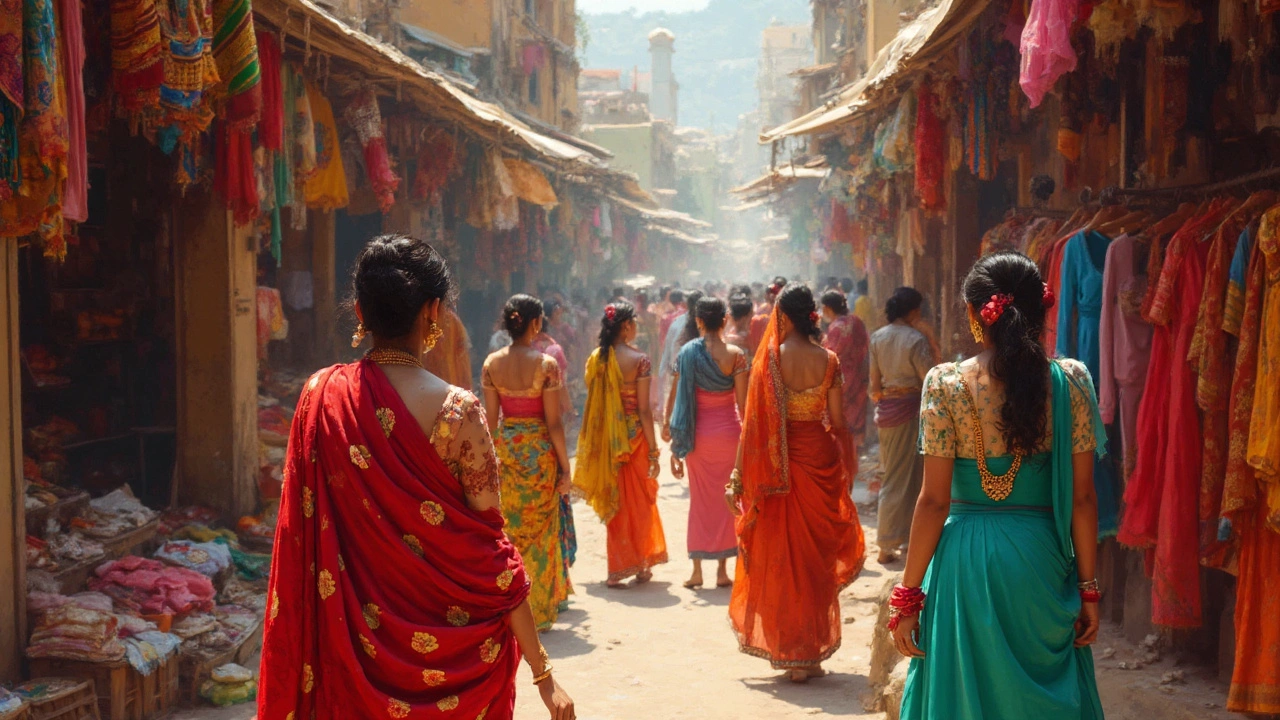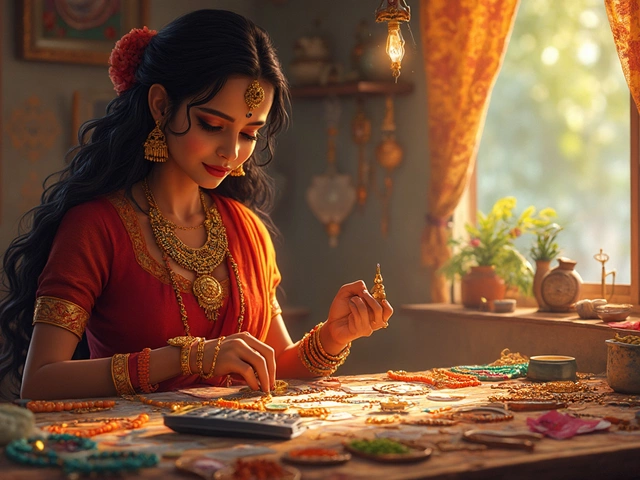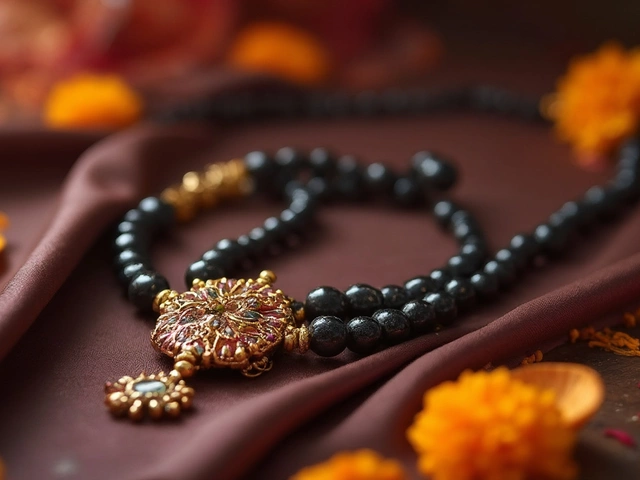Indian fashion is like a kaleidoscope—each spin reveals a unique perspective bursting with colors, fabric, and style. But if you're just getting started, where do you begin? Let's break down some of the most popular types of dresses you'll find across India and what makes them special.
First off, sarees are often the star of Indian wardrobes. These aren't your everyday outfits—they're six to nine yards of grace and elegance. What makes a saree special is its versatility. Whether draped casually or styled for a wedding, a saree can do it all. Fancy a style tip? Pair it with statement jewelry to rock any festive event.
But sarees aren't the only showstopper. Lehenga cholis pop up in most North Indian weddings. With their vibrant skirts and intricate blouses, they've become a bridal favorite. And if comfort is key for you, kurtis offer a chic, everyday option. They combine traditional vibes with the ease of modern wear, making them a go-to for many.
Thinking of trying on one of these styles? Make sure to consider the fabric and region they originate from. Cotton and silk are the go-to for day-to-day wear in southern parts, while wool and heavier materials work well in the north. Varieties are endless, so dive into this world and find what fits you best!
- Traditional Indian Dresses
- Modern Influence on Indian Fashion
- Regional Variations in Indian Attire
- Accessorizing Indian Dresses
- Sustainable Fashion Trends in India
Traditional Indian Dresses
When it comes to Indian dresses, traditional attire holds a special place in both heart and history. From the majestic north to the culturally rich south, each region flaunts its own signature styles that have been cherished for generations.
Iconic Sarees
The saree isn't just a piece of clothing; it's an art form. Worn by women all across India, sarees are incredibly versatile and come in numerous styles. For instance, the Kanjeevaram sarees from Tamil Nadu are known for their rich silk and intricate gold patterns, while Banarasi sarees from Varanasi are famous for their luxurious, fine silk and detailed embroidery.
Lehengas and Ghagras
Moving on to the lehengas and ghagras, these are staples for grand celebrations like weddings. Typically, they feature a long skirt, a blouse, and a dupatta, making them a complete ensemble. Rajasthan and Gujarat are popular for their mirror work and vibrant colors, making the outfits strikingly beautiful.
Graceful Salwar Kameez
Another everyday staple, especially in North India, is the salwar kameez. It's a comfortable yet elegant choice. What's neat about salwar kameez is its adaptability; you can choose from simple cotton for daily wear or go for embellished designs for special occasions.
- Anarkali suits are a specific style of salwar kameez known for their flared silhouettes that add a historical touch.
- Patiala suits offer a unique, playful look with their pleated, baggy pants, perfect for vibrant Punjabi vibes.
Regional Gems
Beyond these mainstream choices, each region boasts traditional attire that deserves a spotlight. Like the elegant Mekhela Chadors from Assam, known for their light, comfortable fabric and intricate motifs. Or the traditional Kerala saree, also called Kasavu, which is simple yet classy with its cream and gold charm.
Overall, Indian fashion is as diverse as its culture. When you adorn a traditional dress, you become a part of a legacy that intertwines history, art, and emotion. Whether you're donning an heirloom piece or trying a new style, it's all about expressing who you are and embracing the cultural richness.
Modern Influence on Indian Fashion
Indian fashion has gracefully adapted to modern influences while still retaining its roots. This mix of tradition and trends is evident in how designers blend traditional attire with contemporary cuts and textiles.
Fusion Styles
Fusion wear is the buzzword here. Think sarees with crop tops, or kurtis paired with jeans. These aren't just fashion experiments; they’re practical solutions for today's fast-paced lifestyle. Women get the cultural beauty of Indian garments with the comfort of Western styles.
Urban Trends
The urban crowd is embracing minimalism in Indian fashion. Pastel shades and understated designs are becoming popular, especially in workwear. Designers like Sabyasachi and Manish Malhotra are known for merging understated elegance with Indian fabrics.
Bollywood's Role
Bollywood continues to play a big role in shaping Indian fashion. Celebrities like Deepika Padukone and Alia Bhatt influence how trends evolve. They are often seen sporting these hybrid styles at both public events and casual outings, making them widely popular among youth.
Technology and e-Commerce
Thanks to e-Commerce platforms, access to a variety of styles is just a click away. Brands are now catering to global markets, making Indian fashion accessible worldwide. Fashion startups are using technology to provide personalized recommendations, making it easier to keep up with rising trends.
If you're looking to update your wardrobe, exploring these modern influences can be refreshing. But remember, the key is to keep it simple. Choose what you feel comfortable in and what represents your style best.
Here's a quick look at some trend options:
- Saree with a Belt: Gives a contemporary twist to the traditional look.
- Shirt Style Kurtis: Offers a casual yet chic option for everyday wear.
- Denim Lehengas: Comfortable and perfect for casual family outings.

Regional Variations in Indian Attire
India's fashion scene is a bubbling pot of regional styles, each with its own unique charm. From Kashmir to Kanyakumari, the diversity is mind-boggling. So, what makes each region stand out? Let's break it down.
North India - A Splash of Royalty
When you think of North India, opulent designs come to mind. The lehengas in Rajasthan, for instance, often feature heavy embroidery and mirror work. Meanwhile, Himachal Pradesh offers stunning woolen shawls, perfect for the chilly climate. For men, a comfortable kurta-pajama set is a staple choice.
South India - Elegance Wrapped in Silk
In the southern part of India, the sarees take center stage, and for a good reason. Kanjivaram sarees, native to Tamil Nadu, boast vibrant colors and rich gold borders, making them a favorite for weddings. Kerala adds its touch with the Kasavu sarees, usually in white with golden borders, symbolizing elegance and purity.
East India - A Burst of Colors
Move towards the east, and you'll find West Bengal's Baluchari and Taant sarees, often adorned with intricate patterns. The northeastern states each have their shawls and wraps, with vibrant designs representing tribal heritage.
West India - A Cultural Canvas
Maharashtra and Gujarat offer some of the most iconic traditional attire. Think nine-yard sarees and colorful chaniya cholis. These clothes aren't just about aesthetics; they represent age-old traditions passed down through generations.
Mid India - Blend of Comfort and Style
Madhya Pradesh's Chanderi and Maheshwari sarees are lightweight, making them perfect for daily wear. Here, women often opt for sarees with simple yet elegant designs, while men stick to classic dhoti-kurtas.
Each region celebrates its heritage through vibrant colors and unique craft techniques. Whether it's the thread work, dyes, or silhouettes, the Indian fashion ecosystem thrives on these diverse influences. These styles not only showcase the rich cultural tapestry but also form an integral part of daily life and festivities.
Accessorizing Indian Dresses
When it comes to completing that Indian look, it's all about the accessories. You can totally change the vibe of your outfit just by adding or swapping a few key pieces. So, what's the secret to accessorizing Indian dresses like a pro?
Jewelry: The Icing on the Cake
Jewelry plays a massive role in Indian fashion. For traditional events, people usually go all out with ornate gold or silver pieces. Think heavy necklaces, jhumkas (dangly earrings), and intricately carved bangles. Got a less formal occasion? Try mixing it up with some sleek, modern pieces or even a chunky statement necklace.
"Jewelry is like the perfect spice – it always compliments what's already there." – Diane Von Furstenberg
Footwear: A Step Ahead
Pairing the right footwear is crucial. Mojaris or juttis are great traditional options that balance comfort with style, especially for ethnic wear. But if you're wearing a saree, high-heeled sandals can really elevate your look—literally and figuratively!
Bags and Clutches: Holding it Together
No ensemble is complete without a chic clutch or potli bag. These not only hold your essentials but add a touch of glam. Go for embroidered or embellished ones to match the richness of a lehengas or sarees.
- For blingy outfits, a simple clutch works best.
- For plainer wear, opt for bags with heavier embellishments.
Bindis and Hair Accessories: The Final Touch
Often underestimated, these small items can have a big impact. A simple bindi can change your face game entirely. Plus, hairpins with intricate designs or fresh flowers in your hair can bring that authentic touch to any outfit.
According to a recent survey, about 65% of women in India believe that accessories complete their ethnic look, making them feel more confident and stylish at events.
| Accessory Type | Occasion Suitability |
|---|---|
| Jewelry | Weddings, Festivals |
| Footwear | Casual, Traditional |
| Clutches | Formal Gatherings |
So, there you have it. With the right accessories, you can transform any traditional attire into something truly your own. Happy styling!

Sustainable Fashion Trends in India
As fashion lovers become more conscious about the planet, sustainable fashion is steadily gaining momentum in India. It's about creating clothes responsibly and minimizing waste, which is an idea many designers and shoppers are embracing here. Let's explore how this is shaping up in the world of Indian fashion.
Eco-Friendly Fabrics
Indian brands are turning to eco-friendly materials like organic cotton, bamboo, and Tencel. These fabrics are not just earth-friendly but also offer the comfort we all crave, especially in varying Indian climates. A popular sustainable brand, No Nasties, has made waves using only 100% organic cotton in their collection. It's also cool to see local artisans reviving age-old handloom techniques, bringing back the charm of handwoven sarees.
Upcycling and Recycling
Upcycling is the new buzzword, and rightly so! This trend takes discarded fabric and turns it into something brand new and stylish. Take Doodlage, a brand making its mark in the industry, offering quirky pieces made from scrap fabric. If you've got old clothes, consider giving them a second life with a bit of creativity—it's not just good for the planet but also adds a unique touch to your wardrobe.
Sustainable Accessories
It's not just about clothes. Fashion accessories in India are also going green. Brands like Studio Coppre are crafting jewelry and home decor items using ethically sourced metals and traditional techniques. Imagine pairing a sleek, hand-beaten copper bracelet with a classic kurti—it’s a look that speaks volumes about personal style and sustainability.
"Sustainable fashion isn't just a trend; it's the future," says Anita Dongre, a leading Indian fashion designer known for her eco-conscious collections.
Consumer Awareness
There's a growing awareness among consumers too. More people are starting to ask questions about what goes into making their clothes. Workshops and online content are educating buyers, especially the younger crowd, on the importance of shopping sustainably.
| Year | Brands Adopting Sustainability |
|---|---|
| 2020 | 25% |
| 2023 | 40% |
| 2025 | Expected 55% |
As we become more conscious of our choices, it's important to remember that fashion's beauty lies in its power to express individuality—responsibly. Let's support brands and ideas that not only make us look good but also make us feel good about our choices.



